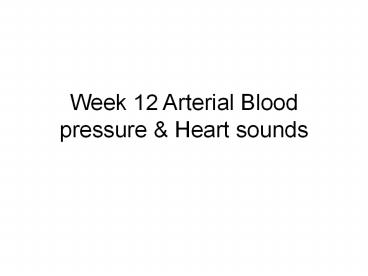Week 12 Arterial Blood pressure - PowerPoint PPT Presentation
Title:
Week 12 Arterial Blood pressure
Description:
Week 12 Arterial Blood pressure & Heart sounds Systole: ventricle contraction Diastole: ventricle relaxation Systole and diastole = one cardio cycle Sounds of ... – PowerPoint PPT presentation
Number of Views:122
Avg rating:3.0/5.0
Title: Week 12 Arterial Blood pressure
1
Week 12 Arterial Blood pressure Heart sounds
2
- Systole ventricle contraction
- Diastole ventricle relaxation
- Systole and diastole one cardio cycle
3
BLOOD PRESSURE
- Blood pressure is defined as the pressure of the
blood exerts against the blood vessel walls
(arteries). - The highest blood pressure that results from
contraction of the ventricles of the heart is the
systolic pressure - the force of blood in your arteries as the heart
contracts and pushes it out - The lowest blood pressure that results from
relaxation of the ventricles is the diastolic
pressure - the force of your blood between heartbeats
- A measurement of 130 / 85 reflects a systolic
pressure of 130 and diastolic pressure of 85.
4
MEASURING BLOOD PRESSURE
- To measure blood pressure, place the blood
pressure cuff, sphygmomanometer, and stethoscope
as shown in the diagram. - measured as the brachial artery compressed by a
blood pressure cuff - A stethoscope is used to hear sounds that result
from the compression and release of pressure on
the blood vessel. - Pronounced
- (sfig-mo-ma-nom-e-ter)
5
Blood pressure reading
- Place the cuff so that it just fits the arm, and
is neither too tight nor too loose. - Inflate the cuff so that the sphygmomanometer
reads at least 160. You should not hear any
sounds at this point. - Slowly deflate the cuff, and note the reading
when you begin to hear thumping/sharp tapping
sounds through the stethoscope. This reading is
the systolic pressure (the first sound of
Korotkoff). - Continue deflating the cuff until the thumping
sound stops/muffles, and note the reading. This
is the diastolic pressure (the second sound of
Korotkoff). - Finish deflating the cuff, and remove it from the
arm. - Wait ten minutes before attempting to take a
second blood pressure reading on the same person.
6
Sounds of Korotkoff
- Sound is created by turbulent flow of blood
through the compressed vessel - Sound disappear when the vessel is no longer
compressed by the pressure cuff and normal
(non-turbulent) laminar flow resumes
7
Factors that affect BP
- Genetics
- Age
- Body weight
- State of physical activity
- Level of salt, caffeine, or drugs
8
Closed circulatory system
- Arterial system is connected to the venous system
by means of capillaries - Allows for gas exchange to occur
- Pulmonary circulation
- (Lungs) Pick up O2 and drop off CO2
- Systemic circulation
- (Tissues) Pick up CO2 and drop off O2
9
Relationship between flow, pressure resistance
- F P/R
- F flow
- P pressure
- R resistance
10
Average rate of blood flow (pressure)
- Mean Arterial Pressure
- pulse pressure diastolic pressure
- 3
- Pulse Pressure systolic pressure diastolic
pressure - OR
- (systolic pressure 2x diastolic pressure)
- 3
11
MAP
120mmHg
75mmHg
12
Heart sounds
13
Pathway of blood flow
- (from tissues) dO2 blood enters R. atrium via
superior inferior vena cava ? tricuspid valve ?
R. ventricle ? pulmonary semilunar valve ?
pulmonary (trunk) arteries ? lungs ? drop off dO2
blood pick up O2 blood - (from lungs) O2 blood enters L. atrium via
pulmonary veins ? bicuspid valve ? L. ventricle ?
aortic semilunar valve ? aorta ? rest of the body
14
Auscultation areas using a stethoscope.
- SL valves
- Aortic valve
- Pulmonary valve
- AV valves
- Tricuspid valve
- Bicuspid valve
15
Four major heart sounds
- Heart Sounds lub and dup
- First Sound (S1) occurs during ventricular
systole. Under low pressure, closure of the
atrioventricular (AV) valves and opening of the
semilunar (SL) valves ? lup - Second Sound (S2) occurs during ventricular
diastole. Under high pressure, closure of the SL
valves and opening of the AV valves ? dup - Third Sound (S3) turbulence associated with
rapid filling of the ventricles shortly after
opening of the AV valves - Forth Sound (S4) turbulence associated with the
passage of blood from the atria into the
ventricles during atrial systole
16
Ventricles
- Diastole the period of ventricular filling
(relaxation), the AV valve open SL valves are
closed to prevent arterial blood from re-entering
the heart - Systole when the ventricles contract compress
the blood in their chambers, closes the AV valves
(prevents backflow into atria) SL valves are
forced open as the ventricles discharge the blood
into the large arteries
17
Phases of the Cardiac Cycle
Fig. 12-18 on p 374
End-Diastolic Volume
Isovolumetric contraction
Isovolumetric relaxation
End-Systolic Volume
Stroke Volume
18
Fig. 12-19
- (a) Atrial contraction begins (S4)
- Atria eject blood into ventricles
- (b) Atrial systole ends AV valves close (S1)
- (c) ventricular contraction
- (d) Ventricular ejection occurs
- Semilunar valves close (S2)
- (e) relaxation occurs
- (f) AV valves open passive ventricular filling
occurs (S3)
19
(No Transcript)































